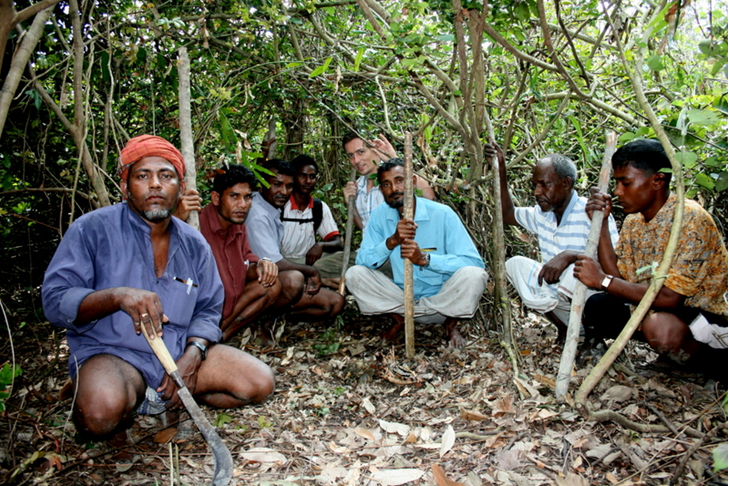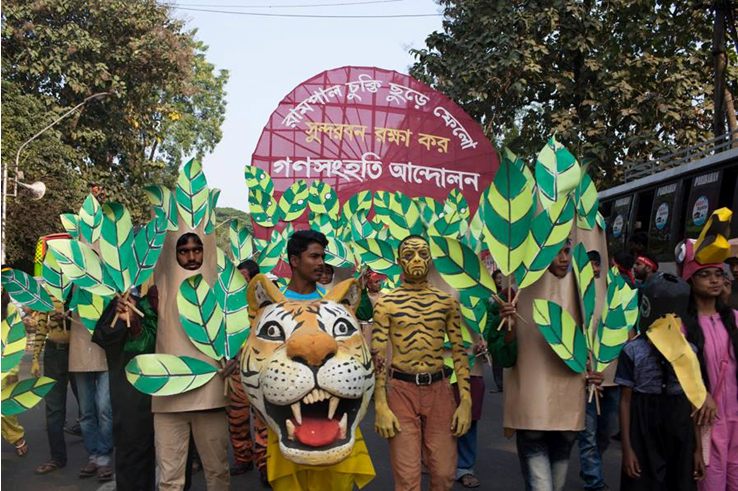- The government’s decision increases the proportion of the Bangladesh Sundarbans that is off-limits to people from 23 to 52 percent, although pollution from a proposed coal power plant nearby would be an ongoing risk.
- Locals living near the forest have minimized the number of tigers killed in conflict with humans by forming response teams that ward tigers away from villages.
- Policy tailored to addressing the myriad reasons for tiger killing would have even more success in reversing the decline of the Bengal tiger, research suggests.
In the world’s largest mangrove forest, the Bengal tiger (Panthera tigris tigris) lives unaware of the debate surrounding its survival. Its home, the Sundarbans, stretches like a green wall across 10,000 square kilometers (3,861 square miles) of the South Asian coast, standing between Bangladesh and a Bay of Bengal made increasingly volatile as a result of climate change. Since a study in 2015 revealed there were only 106 tigers left in the Sundarbans – a number four times smaller than previously thought – the government has been under increasing pressure to act boldly to meet its commitment at the Global Tiger Forum summit of doubling wild tiger populations by 2022. In August, the Bangladesh government doubled the size of its wildlife sanctuary to enclose 52 percent of the forest’s area – forbidding access to local people in a bid to force out tiger poachers.
Although seemingly benign, the decision overlooks growing tensions in Bangladeshi society over the future of the forest and its biodiversity. To some, the sanctuary expansion is an ambitious effort to reverse decades of tiger poaching; to others, it is an empty gesture intended to disguise the creeping industrialization of a World Heritage Site.
A local newspaper describes the Sundarbans as “a fragile ark”, and indeed, the mangrove forest shelters around 3,000 species of plants and animals, a number of which – including the Bengal tiger – are endangered.
But the biology of the mangrove tree defies any label of “fragile”. It is unique among flowering plants in its preference for the intertidal environment, withstanding inundation by salt water to thrive on tropical coasts. Its dense root systems slow the advance of tidal surges during cyclones, helping to dissipate the destructive energy of storms before they can hit human habitations on land. As climate change ramps up the ferocity of extreme weather events, the Sundarbans stands as a vital first line of defense for the people of Bangladesh.

Little wonder that when translated from Bengali, Sundarbans means “beautiful forest”. Affection for the ecosystem among the people of Bangladesh also stems from its capacity to provide some 350,000 of them with an income. Foraging for fish, honey and other resources has sustained communities here for thousands of years, but the expanded sanctuary would outlaw this in over half of the territory.

The government insists that the change will help both tigers and people in the long run.
“This means more security for wildlife and their habitat,” said Modinul Ahsan, an officer at the division of Wildlife and Nature Conservation in the Bangladesh Forest Department.
The proposal would more than double the no-take area to 3,129 square kilometers (1,208 square miles), just over half of the country’s total forest area of 6,017 square kilometers (2,323 square miles). Within its boundaries, no hunting or gathering will be permitted. Outside of them, where locals previously had unrestricted access, only licensed gathering for fish, honey and nipa palm leaves will be allowed.
“People will benefit because the sanctuary will protect the breeding grounds of wildlife … and [their children] will move to the non-protected areas and the people will be able to harvest fish from the upstream portion of the forests,” Ahsan said.
However, the upper reaches of the Sundarbans may not emerge as wildlife-friendly as Ahsan claims, if other government plans go ahead. Scheduled to begin operating in 2021, the Rampal coal power plant would sit 12 kilometers north of the Sundarbans. Experts fear its planned burning of 4.7 million tons of coal a year would expose the delta forests of India and Bangladesh – where one in five of the world’s Bengal tigers live – to acid rain, smog and potential coal slurry spills.
Abdullah Harun Chowdhury, an environmental science professor at Khulna University, Bangladesh, conducted his own assessment of the plant’s likely impacts and concluded that chronic pollution of the air and water in the forest would degrade the immune systems of animals living there, allowing disease to spread. Over time, he argued, the coal plant would negate any benefit to tigers from a bigger sanctuary.
“Just think if you or I had a very large house to live in but the house is always receiving polluted air, water and food. Could we stay in that house for long without facing any problems?” Chowdhury asked. “Expanding the area of a sanctuary cannot mitigate the problem if it isn’t pollution free.”

Local people would also be put at greater risk of developing respiratory illnesses with the coal plant nearby, Chowdhury argued.
Officials working on the Rampal project did not respond to requests for comment.
Ahsan, of the forest department, told Mongabay that alternative livelihoods were being prepared for people who could no longer access the forest – although he acknowledged the government had not sought to involve them in the planning of the expansion.
“Since the government is the custodian of the forests, [we] do not need to consult with the local people because everything is done for [their] greater interest,” he said.
In the villages that surround the forest, residents have launched their own initiatives to halt the decline in tiger numbers. Alongside poaching, tigers are at risk when they wander into human habitations, leading fearful villagers to attack and kill them. Human-tiger conflicts have long been a major concern, but things are changing.
“A phrase you will often hear from villagers is that ‘if the tiger goes, the forest will go,’” said Adam Barlow, executive director of Wild Team, an NGO that supports and trains local people to become tiger response volunteers. With dedicated teams in 49 villages, responders alert the forest department when a tiger is sighted and work together to safely herd it back into the forest.
In the last nine years of the program, Wild Team says it has seen a steady decline in the numbers of tigers lost to defensive killing by humans. Since 2013, there have been no reports of such killings.

Wild Team works to promote harmony between villagers and tigers in the Sundarbans by appealing to the people’s cultural reverence for the species and forest with which they share their homes. They also aim to reduce poaching of tigers and their prey, such as deer.
“This campaign is already making a positive impact on people’s attitudes and there are many signs that the villagers are making it more and more difficult for poachers to operate. For example, there has been a major increase in arrests of poachers over the past few years, which would only have been possible with the information provided by the local people,” Barlow said.
Rezvin Akter, a coordinator for Wild Team in Bangladesh, hailed the government’s decision to expand the wildlife sanctuary as “an important milestone” that would help the work of volunteers in creating “an undisturbed habitat for the tigers”.

“I feel optimistic that the local people have, despite the hardships they sometimes face from tiger attacks, a deeply felt value for the forest and its tigers,” Barlow added.
Research published last year, however, revealed there are many different groups of people who kill tigers, and often for very different reasons. Samia Saif, a local tiger expert who authored the study, argues that until the causes of wildlife decline are addressed in government policy, the tiger sanctuary will remain insufficient.
“From a poaching point of view, [the expansion] won’t impact on the scale of poaching as professional tiger poachers and pirates are not bothered whether it is a protected area or not,” said Saif, a research fellow at the Bangladesh Center for Advanced Studies and former assistant coordinator at Wild Team.
Poachers supply an international trade in tiger bones, often reaching East Asian markets for use in traditional medicines. A local form of traditional medicine, kobiraj, also makes use of tiger parts, while sport hunting and the accidental killing of tigers in snares set for deer are among the other threats.
For a conservation effort that addresses all of these threats, Saif’s study proposes multiple actions: improving education and healthcare access in remote forest communities to puncture the appeal of kobiraj; offering amnesty to poachers and rewards for relinquishing weapons; and providing opportunities for alternative careers, such as growing seaweed.
“Tougher enforcement alone will not succeed in reducing tiger killings,” her study concludes. “A more dynamic and multifaceted strategy that can address the various motives and opportunities for tiger killing is required to meet the global goal of doubling the wild tiger population by 2022.”
Activists are even more skeptical that meaningful progress for tigers can be made while a coal power plant looms in development on the forest’s edge.
Anu Muhammad led a 15,000-strong march of people through the capital Dhaka last November to “Scrap Rampal and Save the Sundarbans.” As member secretary of the National Oil, Gas, Mineral Resources, Power and Port Protection Committee, an NGO, Muhammad supports an alternative energy vision for Bangladesh, prioritizing renewable energy and public ownership.


“People in Dhaka and in many other parts of the country have been protesting against coal-fired power as scientific evidence convinces them that this plant will ruin the forest and leave Bangladesh totally unprotected,” Muhammad said. “As the government is biased toward business at the cost of people and the environment, the people find no other option than to take to the streets.”
So far activists have forced the cancellation of Orion, a second, smaller coal power plant that would have operated alongside Rampal. The result has buoyed hopes in the anti-coal movement for further concessions through continued pressure on the government. Energy researcher and renewables advocate Mowdud Rahman is confident that Rampal is the last gasp of a sector in decline, claiming that coal generation accounted for only 1.62 percent of Bangladesh’s total energy mix in 2016.
“The dying coal industry is trying to find its resting place in countries where there is a lack of transparency, poor environmental regulation and poor governance. Unfortunately … Bangladesh provides a well-balanced mixture,” he said.
Critics of the government’s decision, like Muhammad, see the enlarged sanctuary as a “paper tiger park” – a flimsy decoy that does little to hide the coal project towering behind it.
“The government’s declaration of a larger sanctuary is highly deceptive. All their actions are against the survival of tigers,” Muhammad said. “Their actual intent is to make the Sundarbans safe for business.”

Header image: A Bengal tiger emerges from the treeline in the Sundarbans tiger sanctuary. Credit: Soumyajit Nandy.
CITATIONS
Chowdhury, A. C. (2017). Environmental Impact of Coal based Power Plant of Rampal on the Sundarbans (World’s Largest Mangrove Forest) and Surrounding Areas. MOJ Ecology & Environmental Science, 2(3), 1-17.
Dey, T. K., Kabir, M. J., Ahsan, M. M., Islam, M. M., Chowdhury, M. M. R., Hassan, S., Roy, M., Qureshi, Q., Naha, D., Kumar, U. & Jhala, Y.V. (2015). First Phase Tiger Status Report of Bangladesh Sundarbans. Bangladesh Forest Department, Ministry of Environment and Forests, Government of Bangladesh.
Mcleod, E., Chmura, G. L., Bouillon, S., Salm, R., Björk, M., Duarte, C. M., Lovelock, C. E., Schlesinger, W. H. & Silliman, B. R. (2011). A blueprint for blue carbon: toward an improved understanding of the role of vegetated coastal habitats in sequestering CO2. Frontiers in Ecology and the Environment, 9(10), 552-560.
Saif, S., Rahman, H. T., & MacMillan, D. C. (2016). Who is killing the tiger Panthera tigris and why?. Oryx, 1-9.
Saif, S., Russell, A. M., Nodie, S. I., Inskip, C., Lahann, P., Barlow, A., Barlow, C. G., Islam, A. & MacMillan, D. C. (2016). Local usage of tiger parts and its role in tiger killing in the Bangladesh Sundarbans. Human Dimensions of Wildlife, 21(2), 95-110.
